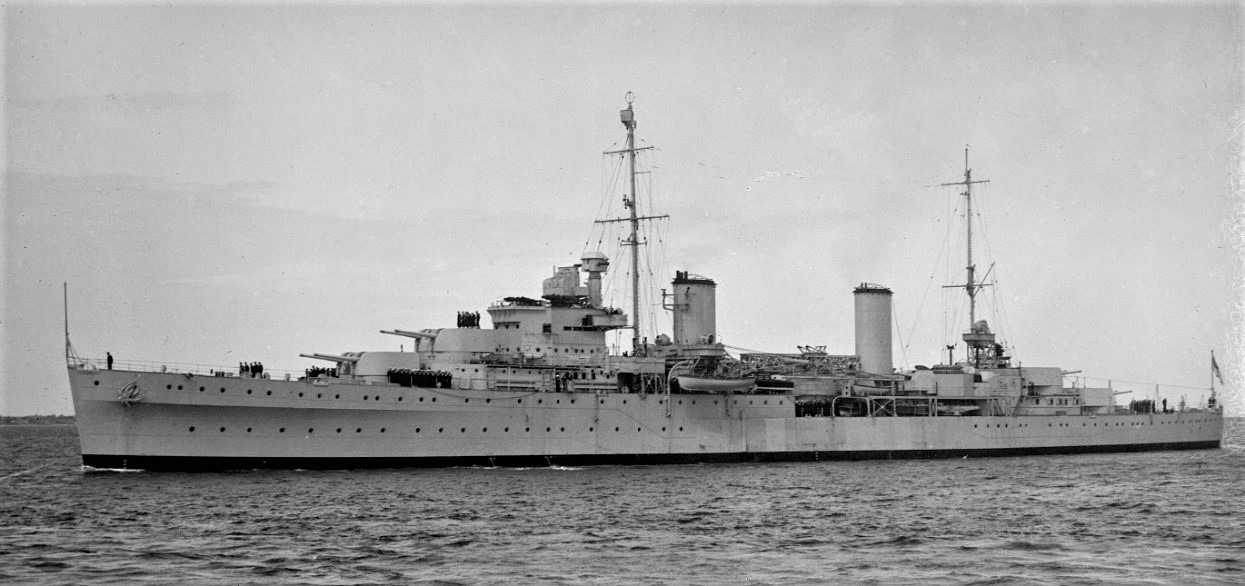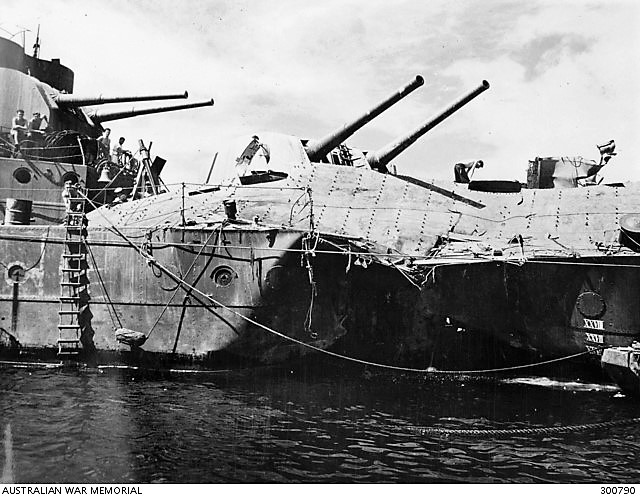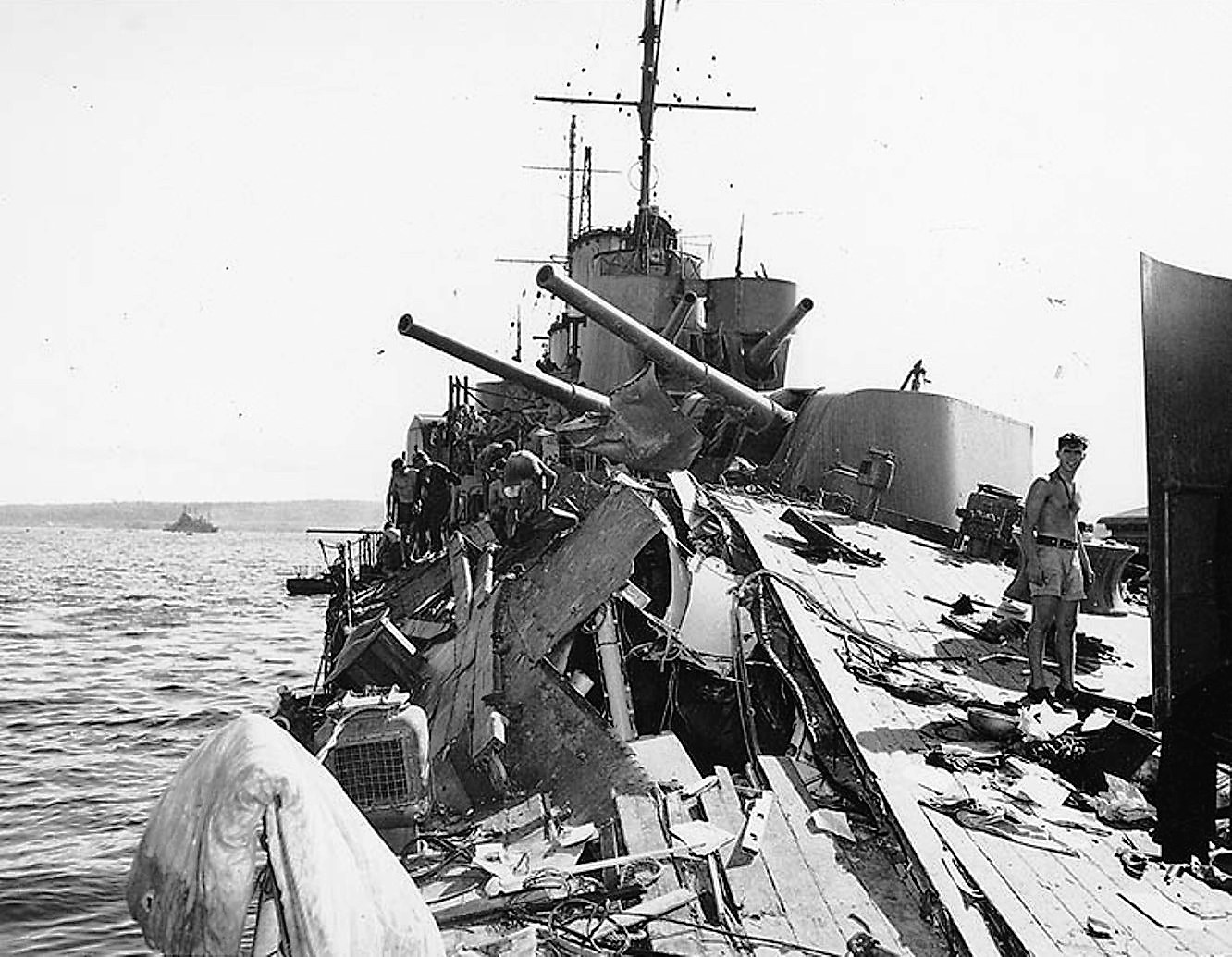- Author
- Parker, R.G., OBE, Captain, RAN (Rtd)
- Subjects
- Ship histories and stories, History - WW2
- Tags
-
- RAN Ships
- None noted.
- Publication
- December 1978 edition of the Naval Historical Review (all rights reserved)
Also published as Occasional Paper 157, March 2023
I JOINED HMAS HOBART at Brisbane in September 1942 as the Commander (E), relieving Commander (E) A.D. Cairns, who had been in the ship since commissioning. HMAS Hobart had just returned for ammunitioning, fuelling, etc., after the Solomons Islands battle in which she had taken part, when HMAS Canberra was sunk off Savo Island in August. I soon found Hobart a ‘happy ship’ under the command of Captain H.A. Showers. The Executive Officer was Commander J.X. Walton and the Senior Engineer Lieutenant (E) S. St. Vincent Welch.
When I joined, I found the Engine-room Department in very good heart, with a high standard of efficiency. However, as the vessel had been steaming continuously in the tropics and had not had a proper refit since the beginning of the war, the team were pretty tired and there were plenty of day-today running defects which had to be made good.

We steamed continuously on the unit system, with all four boilers connected, usually at a speed of about 24 knots. This made it particularly difficult to undertake repairs and maintenance whilst we were actually steaming and the majority of the work had to be undertaken on return to harbour with the ship at two hours notice for steam. Our replenishment base was usually in the Barrier Reef, either at Dunk Island, Palm Islands or Cid Harbour, where we returned for fuel and stores etc. for about three days after ten days patrol in the Coral Sea (‘the Paddock’).
Hobart was part of the United States Navy Task Force 74, the Flagship being HMAS Australia for the majority of the time, with Rear Admiral Crutchley VC in command. There was usually an American cruiser as well and we had USS Phoenix for some time. Our screen generally consisted of about five American destroyers with Selfridge as leader and including Bagley, Blue, Ralph Talbot and Patterson.
Our experiences over twelve months were reasonably dull and routine ones, with the Task Force making a sweep towards Milne Bay by night and turning away before dawn so that we would be out of reach of Japanese reconnaissance aircraft. This pattern was followed almost continuously during the time I was in the ship. The monotony was relieved by cold beer being served to all hands from the store ship HMAS Merkur on return to the Barrier Reef anchorages, together with fishing and oyster gathering trips, as well as softball matches with the American ships.
The Solomons area at this stage of the Pacific War was becoming a critical spot, with the Japanese running the Tokyo Express in the Kula Gulf every night, resulting in heavy casualties amongst the American cruisers operating there – usually torpedoed in the stern with homing torpedoes. Finally, in early July, Australia and Hobart were ordered into the Solomons area, and we had hardly settled down on our new station when orders were received to return south to carry out logistics.
We were torpedoed at approximately 6.45 p.m. on the night of the 20th July by a Japanese submarine with a long range shallow-running torpedo. The weather was fine with extreme visibility as Task Force 74 proceeded to Espiritu Santo. The ships were steaming at 23 knots and zigzagging with the two cruisers in column, with Hobart 600 yards astern of Australia. As the flagship was steaming ahead of us it was probable that they were aiming for the larger ship and not Hobart.

The torpedo struck the port side of the ship, immediately above the Wardroom, abreast Y turret and luckily missing the after magazine by about six feet. Very considerable damage was done, chiefly due to the torpedo being a shallow-run one, with consequent upblast, which was sufficient to lift the 60-ton Y turret off its seating. As a matter of interest, many years later when I was General Manager at Garden Island, my car driver mentioned he was serving in Hobart when she was torpedoed. I enquired as to where he was stationed when the explosion occurred. He said, ‘In Y turret, Sir’, and I asked him what his feelings then were and he said that he had not prayed since he was a small boy, but he prayed very hard at that moment that the turret would land back on the ship. Both port and starboard after propellers and shafting were blown off and the port forward propeller was also badly damaged on two blades.
Casualties were fortunately not as many as could have been a half hour later when the ship would have been closed up at first degree for Action Stations. However the torpedo killed quite a number of the officers who were either in the Wardroom, or Warrant Officers’ Mess, or in their cabins. Those killed were Lieutenant (E) Ellis, Mr. R. Brown, Warrant Engineer in charge of the After Fire and Repair Party, Mr. Calloby, Torpedo Gunner, Surgeon Lieutenant John Gaskell, USN Liaison Officer Lieutenant Slater, and the anti-submarine officer, Sub- Lieutenant Parkin. Paymaster Commander Johnnie Johnstone, and Mr. Tyrrell, Gunner, who were walking on the Quarterdeck, were also lost.

Four of gun’s crew, who had been sitting in a Carley float on the Quarterdeck, ready to man the turret, were also blown over the side and killed, and one officer’s steward and one ordnance artificer were also killed between decks. The effect of the torpedo explosion was very considerable and the whole of the after part of the ship submerged. The ship, fortunately, only took a list of three degrees to port, but all main electrical breakers threw off with the shock and the ship was plunged into darkness.
I had just finished making a nightly routine inspection of the engine and boiler rooms and had reached my cabin immediately above the Wardroom when the explosion occurred. I proceeded to the Wardroom flat below to find secondary lighting on and the After Fire and Repair party assembling under the charge of the Regulating Chief Stoker ‘Darkie’ Goodman. Mr. Connelly, who had been in his cabin at the after end of the ship, crawled through the wreckage and reached the Wardroom flat. As Mr. Brown, who has been in charge of the After Fire and Repair section was killed, I detailed Mr. Connelly to take charge of the party before I proceeded to the forward engine room to ascertain the state of affairs there. Here, it was very heartening to find that the ‘drill’ had been correct, and despite the propeller shafts being blown off, the engines had been stopped on orders from the Bridge, the emergency generators were quickly put on and all engine-room fans restarted. Full lighting was on throughout the ship again inside a couple of minutes. The Senior Engineer, Lieutenant John Dalton and Sub-Lieutenant Brock, who was on watch at the time, and CERA Paddy Ryan, did a fine job in stabilising the conditions.




